




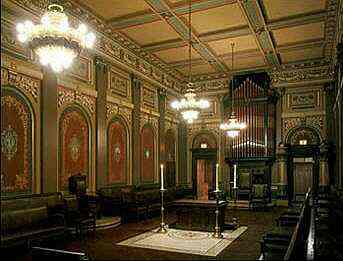
'The Great Revolution prepared for by the Ages'
by, Paul Fisher
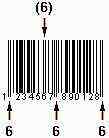 Scottish Rite Masonry's Grand Philosopher and former Grand
Commander wrote that the people, as a mass, are a "blind force,"
which must be "economized and managed" in order to attack
"superstitions, despotism and prejudice." And once the people are
organized and guided by "a brain and a law," and motivated by
Truth and Love, "the great revolution prepared for by the ages
will begin to march."
Scottish Rite Masonry's Grand Philosopher and former Grand
Commander wrote that the people, as a mass, are a "blind force,"
which must be "economized and managed" in order to attack
"superstitions, despotism and prejudice." And once the people are
organized and guided by "a brain and a law," and motivated by
Truth and Love, "the great revolution prepared for by the ages
will begin to march."
He said the force of the people becomes exhausted by prolonglng "things long since dead; in governing mankind by embalming old, dead tyrannies of Faith; restoring dilapidaded dogmas; re-gilding faded, worm-eaten shrines; whitening and rouging ancient and barren superstitions . . . perpetuating superannuated institutions; enforcing the worship of symbols as the actual means of salvation; and tying the dead corpse of the Past . . . with the living present."
"Pike compared the unorganized mass of people to a "Rough Ashlar" [building stone] , and the organized and direct masses as a Perfect Ashlar." It is a concept that had been first enunciated by Adam Weishaupt to guide his Bavarian Illuminati, as was noted earlier in the preceding pages of the book the reader is now pursuing.
The Masonic leader identified Masonry with the Ancient Mysteries and star worship. The sun, moon and Master of the Lodge, he said, are the three sublime lights of Masonry. He characterized the Sun as the ancient symbol of the life-giving and generative power of the Deity. The Moon symbolizes the passive capacity of nature to produce (that is, the female of the species). The Master of Life "was" [emphasis added] the Supreme Deity, above both and manifested through both.
|
Qabalah, Kabbalah, Cabala
From the brilliant misunderstandings and misrepresentations of Alphonse Louis Constant,
who has won fame under the pseudonym of Eliphas Levi, to the highly coloured humbug
of Aleister Crowley and his followers, the most eccentric and fantastic statements have been
produced purporting to be legitimate interpretations of Kabbalism. Qabalah When spelt with a Q indicates Islamic-Sufi derivation. Is said to be closest to original version possibly still practiced by secretive Nuzari/Alawite/Druze/Alevi sect in present day Turkey-Syria-Lebanon-Palestine. Crowley and Thule Society founders studied intensively. Kabbalah When spelt with a K indicates Jewish interpretation or derivation. Claim by present day practioneers that it is the secret teaching Moses received on Mt Sinai has been discredited by Academic Religious Scholars. Instead it's origin's are traced to a small group of Jewish Mystics who translated Sufi Doctrine during the Islamic Moorish period in Spain. Cabala When spelt with a C indicates European-Hermetic-Alchemical-Rosicrucian derivation. Various fanciful claims of transmission including Knights Templar. Freemasonry uses elements from all three 'versions' of Q/K/Cabala. The New Testament v. The Kabbalah
666 is the Mark of the Beast.
666 is the number of the Messiah.
The Gematria of 666 represents Hashem as defender of what is righteous, of what is truth, of what is Holy. We see this in the Gematria of Tzeed Koh Say Nu, meaning {Hashem} our Righteousness! Hashem as the Righteous King judges and punishes all evil.
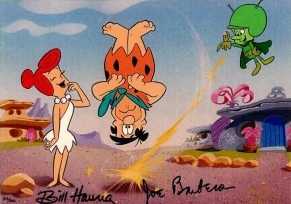 |
In addition to exciting interest among neophyte Masons in pagan religions (which had been almost abandoned with the triumph of Christianity in the Fourth Century, A.D.), Pike's book also presents Masonry as an organization which thrives on tension, conflict and revolution-a struggle apparently directed toward what Pike called "the great revolution prepared for by the ages," which would usher in the "universal social republic," mentioned by Fr. Gruber.
Lectures based on Pike's philosophy should immediately impress perceptive Masons that the tension, conflict and revolution referred to is the age-old pagan conflict with Christianity particularly the Roman Catholic Church. The alternating black and white squares on the Lodge floor Pike noted, serve to remind all Masons of that constant conflict. Those alternating blocks symbolize, he said, the "warfare of Michael and Satan; between light and darkness; freedom and despotism ; religious liberty and the arbitrary dogmas of a Church that thinks for its votaries, and whose, Pontiff claims to be infallible, and the decretals of its Councils to constitute gospel." Freemasonry, Pike said, owes its "success to opposition."
Pike made it abundantly evident that Masonry has nothing to do with Old and New Testament religious values. The Craft, he insisted, is the successor of the Ancient Mysteries, and teaches and preserves the cardinal tenets of the old primitive faith. AII old religions "have died away and old faiths faded into oblivion;" but Masonry survives "teaching the same old truths as the Essenes taught and as John the Baptist preached in the desert."
Masonry's "same old truths," were gathered "from the ZendAvesta and the Vedos, from Plato and Pythagoras, from India, Persia, Phonecia, Greece, Egypt and the Holy Books of the Jews . . . These doctrines are the religion and philosophy of Masonry." Obviously, Masonic philosophy makes no room for Christian truths, ethics and values.
Elaborating on Masonic philosophy, Pike sald that while Christian Masons may believe the Divine Word became Man, others believe the same thing happened long before to Mithra and Osiris. Therefore, Christians should not object if others see in the Word of St. John what actualiy is the Logos of Plato or the Unuttered Thought of the first emanation of light or the Perfect Reason. "We do not admit that the Messiah was born in Bethlehem."
 The "truths" propagated by Masonry, Pike wrote, are based upon
Jewish mystical lore known as Kabbalistic Gnosticism. which was
passed to Masonry through the Knights Templar.
The "truths" propagated by Masonry, Pike wrote, are based upon
Jewish mystical lore known as Kabbalistic Gnosticism. which was
passed to Masonry through the Knights Templar.
Explaining, Pike said there existed at the time of the Templars a sect of "Johannite Christians, who claimed to be the only true initiates into the real mysteries" of the religion of Christ. Adopting in part the Jewish traditions and tales of the Talmud, they said facts recounted in the Gospels "are but allegories."
The Knights Templar, he continued, were from the very beginning "devoted to . . . opposition to the tiara of Rome and the crown of its Chiefs. . . "
The object of the Templars, he said, was to acquire influence and wealth, then to "intrigue and at need fight to establish the Johannite or Gnostic and Kabbalistic dogma. . . "
Again identifying Freemasonry with the Knights Templar, Pike declared: "The Papacy and rival monarchies . . . are sold and bought in these days, become corrupt, and tomorrow, perhaps, will destroy each other. All that will become the heritage of the Temple: the World will soon come to us for its Sovereigns and Pontiffs. We shall constitute the equilibrium of the universe, and be rulers over the masters of the world."
He said the Templars, like other secret societies, had two doctrines: One was concealed and reserved for the Masters, which was Johannism; the other, publicly practiced, was Roman Catholic. Thus, Freemasonry, he said, "vulgarly imagined to have begun with the Dionysian Architects or German Stone-workers, adopted St. John the Evangelist as one of its patrons, associating with him in order not to arouse the suspicion of Rome . . . [and] thus covertly proclaiming itself the child of the Kabbalah and Essenism together."
The Johannism of the Adepts, he added, "was the Kabbalah of the earlier Gnostics."
Referring to the trial of the Templars, (which lasted from 1307 to 1314, and involved charges that Templars denied Christ was God, abjured other basic Catholic beliefs, including the Sacraments, spat and urinated upon the Crucifix , and regularly engaged in homosexuality and other obscene acts), Pike said: Pope Clement V and Philip the Fair [of France] could not fully explain to the people at large "the conspiracy of the Templars against the Thrones and the Tiara. To do so would propagate the religion of Isis."
Jacques De Molay, Grand Master of the Knights Templar was executed in 1314. However, before he died, according to Pike, he instituted what came to be called the occult Hermetic or Scottish Masonry, the Lodges of which were established in four metropolitan areas , Naples, Edinburg, Stockholm, and Paris. These Lodges, Pike asserted, were the initial Lodges of modern Freemasonry.
 The former Grand Commander of the Scottish Rite also asserted
that the secret movers of the French Revolution had sworn upon
the tomb of De Molay to overthrow Throne and Altar. Then, when
King Louis XVI of France was executed [1793], "half the work was
done; thenceforward, the Army of the Temple was to direct all it's
efforts against the Pope."
The former Grand Commander of the Scottish Rite also asserted
that the secret movers of the French Revolution had sworn upon
the tomb of De Molay to overthrow Throne and Altar. Then, when
King Louis XVI of France was executed [1793], "half the work was
done; thenceforward, the Army of the Temple was to direct all it's
efforts against the Pope."
The Church and Christianity are clearly the major enemies of Pike's Freemasonry. Christianity, he said, taught the doctrine of Fraternity, but repudiated that of political equality because it inculcated obedience to Caesar and to those lawfully in authority.
According to Pike, the Samaritan Jews, using Kabbalistic data, characterized the "vulgar faith" by the figure of Thartac, a god represented with a book, a clock, and the head of an ass. This was because they believed Christianity was under the reign of Thartac, since its adherents preferred "blind faith and utter credulity . . . to intelligence and science.
Concerning Heaven and Hell, Pike wrote: "The present is Masonry's scene of action-man is on earth to live , to enjoy. He is not in this world to hanker after another.
The unseen can not hold a higher place in our affections than the seen," he declared, and added: Only those "who have a deep affection for this world will work for its amelioration.
Ascetism, said Pike, is "unnattural" and "moribund." Those whose affections are transferred to Heaven, easily acquiesce in the miseries of earth. "Those given most decidedly to spirital contemplation, and make religion rule their life are most apathetic toward improving this world's systems. They are conservators of evil and hostile to political and social reform."
 The writings of the Apostoles, Pike said, were only "articles of
the vulgar faith." The real mysteries of knowledge handed down
from generation to generation by superior minds were the
teachings of the Gnostics . . . and in them [we find] some of the
ideas that form part of Masonry."
The writings of the Apostoles, Pike said, were only "articles of
the vulgar faith." The real mysteries of knowledge handed down
from generation to generation by superior minds were the
teachings of the Gnostics . . . and in them [we find] some of the
ideas that form part of Masonry."
To Pike, Christ was not unique. The fundamental teachings concerning Jesus are commonly believed of Krishna, the Hindu Redeemer, he said. Born of a virgin, performing miracles, raising people from the dead. Krishna descended into Hell, rose again, ascended into Heaven, charged his disciples to teach doctrines and gave them a gift of miracles.
Speaking of the Catholic Church, Pike wrote: "By what right . . . does the savage, merciless, persecuting animal endeavor to delude itself that it is not an animal?"
In his commentary on the Council of Kadosh, Pike inferentially referred to the Holy Eucharist, and said:
The chief symbol of man's ultimate redemption is the fraternal supper of bread and wine. This fraternal meal teaches among other things "that many thousands who died before us might claim to be joint owners with ourselves of the particles that compose our mortal bodies, for matter ever forms new combinations: and the bodies of the ancient dead, the Patriarchs before and since the mood, the Kings and common people of all ages, resolved into their constituent elements, are carried upon the wind over all continents, and continually enter into and form part of the habitations of new souls creating new bonds of sympathy and brotherhood between each man that lives and all his race.
"And thus the bread we eat, and the wine we drink tonight may enter into and form part of us the identical particles of matter that once formed parts of the material bodies called Moses, Confucius, Plato, Socrates, or Jesus of Nazareth. In the truest sense we eat and drink the bodies of the dead...."
Over and over again, Morals and Dogma (MAD) emphasizes that Freemasonry is a religion based on the occult Jewish philosophy found in the Kabbalah.
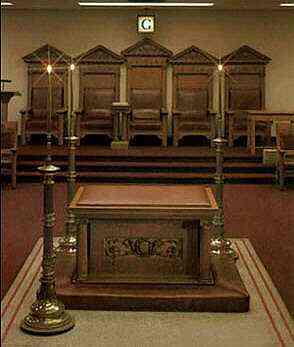 The key to the true meaning of the symbols within the Temple is
found in the occult philosophy of the Kabbalah, Pike said, and
subsequently asserted that Masonry owes all its symbols and
secrets to the Kabbalah.
The key to the true meaning of the symbols within the Temple is
found in the occult philosophy of the Kabbalah, Pike said, and
subsequently asserted that Masonry owes all its symbols and
secrets to the Kabbalah.
"It is the province of Masonry to teach all truths, not moral truth alone, but political and philosophical, and even religious truth," he said. Masonry, he insisted is "the universal morality."
And again: "The religious faith . . . taught by Masonry is indispensable to the attainment of the great ends of life. . . " Pike proclaimed that "every Masonic Lodge is a temple of religion; and its teachings are instruction in religion. . . "
The Degree Rose Cross teaches "the ultimate defeat and extinction of evil and wrong and sorrow by a Redeemer or Messiah yet to come, if he has not already appeared."
Earlier commentators on Masonry have contended that Masonry is a State within the State. Morals and Dogma gives credence to that view by insisting that Masonry determines whether heads of State should stay in power.
"Edicts by a despotic power contrary to the Law of God or the Great Law" of Nature, destructive of the inherent rights of man, and violative of the right of free thought, free speech, free conscience warrant lawful rebellion, he said And, he noted, "resistance to power usurped is not merely a duty which man owes to himself and his neighbor, but a duty which he owes to his God.:
If rulers have the Divine Right to govern, the true Masonic initiate will cheerfully obey, said Pike.
The problem faced by both rulers and people is to know who has a "Divine Right" to govern; and how much freedom is permitted for speech and conscience in a state before rebellion is warranted. Morals and Dogma strongly indicates that Masonry alone will make such determinations.
Pike also makes clear that those in the lower degrees of Masonry are "intentionally misled by false interpretions" of the symbols of the Craft. "It is not intended," he said that Masons in the Blue Degrees (the first three degrees) "shall understand them; but it is intended that [they] shall imagine" they do. The true explanations of the symbols are "reserved for the Adepts, the Princes of Masonry," he said.
Those are some highlights from a book that has been extolled in the New Age magazine for over 60 years as the plilosophic foundation upon which Scottish Rite Freemasonry stands. While many members of the Fraternity have found the book turgid and tedious, obviously many others look upon it as a great source of wisdom. In January, 1950, the Scottish Rite Committee on Publications reminded members of the Craft that they were "expected to be leaders and teachers of the people," and that the basic philosophy undergirding their efforts must be Morals and Dogma.
It can be little doubted that Pike had the pulse of Masonry. And long prior to publication of his opus, the Supreme Council of the Scottish Rite of the Southern Jurisdiction issued a circular which asserted: "Above the idea of country is the idea of humanity."
A Mason has written that Masonry exists the world over "and is susceptible of forming, at any moment, with its various Masonries, a homogenous bloc, or mass, pursuing a common ideal. That ideal is the emancipation of Humanity."
 One well-informed non-Masonic student of the Craft said that to
promote the Masonic concept of "the welfare of humanity" and
elimination of "ignorance and prejudice" meant in practical terms
Masonic attacks on altar and throne.
One well-informed non-Masonic student of the Craft said that to
promote the Masonic concept of "the welfare of humanity" and
elimination of "ignorance and prejudice" meant in practical terms
Masonic attacks on altar and throne.
The same source also said the true purpose of Freemasonry is "the fall of all dogmas and the ruin of all churches."
The Grand Commander of Scottish Rite Masonry of the Southern
Jurdisdiction revealed that Manuel Quezon, first President of the
Philippines Senate and later the first President of the
Philippine Commonwealth, declined to accept the "rank and
dignity" of the 33rd degree of Freemasonry, because he "feared,
some way, sometime, that there might be some obligation in
accepting the honor which would be in conflict with his
allegiance to the Philippines."
 Excerpt
Excerpt
Behind the Lodge Door
Paul Fisher
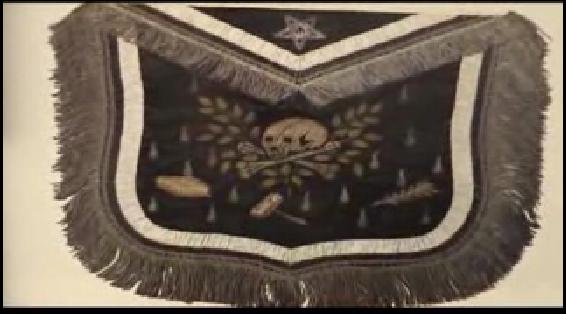
And I saw one of his heads as it were wounded to death; and his deadly wound was healed: and all the world wondered after the beast.
Revelation of St. John the Evangelist 13:3
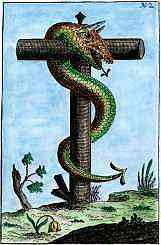

And they worshipped the dragon which gave power unto the beast: and they worshipped the beast, saying, Who is like unto the beast? Who is able to make war with him?
Revelation of St. John the Evangelist 13:4

The 5th Station of the Cross, 'Way of the Cross' nighttime procession, World Youth Day 2002, University Avenue, Toronto, Canada. Images of Satan and Cain laughing at Jesus Christ as he stumbles under the weight of his cross before Calvary, drawn on a blue angled backdrop held by Passion reenactors. Produced, Directed, and Designed by The Vicar of Christ, Pope John Paul II.
Craftyness - Obelisks, Statutes & Plots: The 'Master' Planned Community
Keystone Kraft Koncepts (G.L.O.S.)